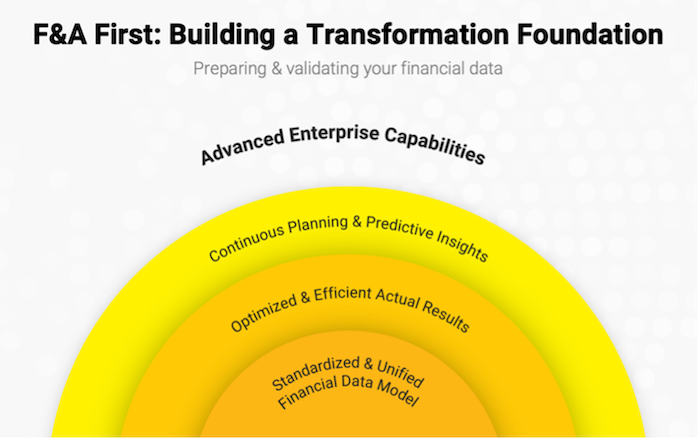Today’s business environment is more dynamic than ever. Business leaders are focused on strategic initiatives to position their companies for long-term growth, to gain competitive advantage, and to drive shareholder value.
Top of mind for many business leaders are topics like recruiting and retaining top talent, remote work enablement, ESG, and digital transformation, to name a few.
As business leaders focus on making strategic decisions around these areas, accounting teams are increasingly relied upon to provide data and insights, and to serve as strategic advisors to the business.
This post is part of a series that discusses areas of focus that require active accounting input, why it matters to accounting leaders, and the risk of doing nothing.
A Focus on Digital Transformation
In an ever-changing business environment, competitive advantage and continued growth are difficult to create and to sustain. According to Innosight’s 2021 Corporate Longevity Forecast, there is a steady churn rate of companies dropping off the S&P 500, fueled by new entrants joining the list and a decline in corporate lifespan. Companies thriving in today’s environment are digitally focused and agile.
Companies that successfully leverage technology to turn data into meaningful insights are well positioned for long-term growth. According to Deloitte’s Digital Transformation Executive Survey, more digitally integrated organizations measurably outperformed industry competitors on their strategic objectives, capacity to change, and ability to win. Establishing a digital transformation strategy is critical to success.
An essential component to developing a digital transformation strategy is evaluating the company’s enterprise resource planning (ERP) system. ERP systems connect functions across the business for a more streamlined and collaborative organization. Functions like sales, supply chain, human resources, and finance and accounting become unified. As new technology emerges, business leaders are looking to upgrade their ERP system and further modernize to drive business innovation.
An F&A First Approach to Transformation
Business leaders are increasingly relying on finance and accounting (F&A) to understand the impacts of business activities and inform business decisions. According to Accenture, 99% of CFOs agree that it’s important to have real-time processes and operations in place to better inform business decisions. Without the proper F&A technology, it is a challenge to provide timely, accurate, and complete data to business partners.
F&A leaders need to ensure their teams are well positioned to provide meaningful insights to business partners. As organizations embark on modernizing their technology landscape and upgrading their ERP, finance and accounting leaders can build a transformation foundation by taking an F&A first approach.
This type of approach prioritizes a data foundation and actual results to enable the broader enterprise strategy. Advanced enterprise capabilities are achieved when data is leveraged as a valuable and strategic resource to informing decisions and business strategy. In other words, an F&A first approach to transformation delivers data as an enterprise asset.

To establish data as a foundation, a standardized and unified financial data model must be defined. For example, defining the internal and external needs for reporting, including information needed to support revenues by segment, profitability, pricing, M&A activity, divestures, and audits. It is important to not only define the data model, but also to establish sustainable, scalable, data standards and governance informed by the decisions that the organization is looking to drive.
Once a standardized and unified financial data model is established, then optimized and efficient actual results can be delivered. F&A leaders should focus on close optimization and continuous accounting principles to deliver timely and accurate actuals to their organization. Activities can move out of the close window, providing the business with faster, more precise data that supports the ability to execute on-demand analytics.
Optimized and efficient actual results are then a predecessor for supporting continuous planning and predictive insights. Decisions can be made based on complete and accurate information, with the necessary attribution, that is delivered faster to support the business and inform decision making.
This in turn, allows for advanced enterprise capabilities that the organization is setting out to achieve with the broader enterprise-wide digital transformation and ERP upgrade. The business is equipped with timely, accurate data such as KPIs and profitability, which can then be used to make critical decisions.
By taking an F&A first approach and creating the foundation of quality data, the other functions of the business can tie into this data model and effectively deliver the broader enterprise-wide digital transformation, including the ERP upgrade.
Taking an F&A first approach to your digital transformation and ERP upgrade is no regret, as finance is foundationally required.
The Risk of Doing Nothing
The ERP system is an integral part of the organization and, when deployed appropriately, can position the organization to turn data into meaningful insights and unlock competitive advantage. Without having the right ERP system and digital strategy, organizations are faced with manual processes that take too long and introduce unnecessary risk across the organization, including within F&A. These challenges will continue to persist, and organizations will miss critical opportunities for innovation and growth, if the organization does not address the underlying systems. Having the right ERP is critical to future proofing the core of your business.
When organizations embark on their digital transformation strategy and upgrade their ERP, it requires significant support from F&A leaders and their teams. Without the appropriate F&A subject matter expertise on ERP project teams, legacy processes are migrated into new ERPs. In many legacy processes, F&A teams are often faced with challenges of accessing complete and accurate data timely, as information is often decentralized across numerous sources and processes are often complex and disaggregated. In addition, F&A teams spend time on heavily manual and spreadsheet-dependent processes.
F&A leaders and their teams need to be actively involved in preparing for and supporting the ERP upgrade and broader digital transformation strategy to ensure opportunities for optimization are not missed.
How BlackLine Can Help
The BlackLine platform enables an F&A first approach. By augmenting the ERP, BlackLine helps organizations achieve an integrated and continuous end-to-end finance and accounting model that helps to deliver optimized and efficient actuals.
In addition to providing incremental capabilities for manual F&A processes that exist outside of the ERP, BlackLine can help F&A organizations make the transition to a target model by:
- Centralizing data and processes—unify information across disparate data sources in a single platform that integrates seamlessly with your legacy and new ERP
- Improving balance sheet readiness—prepare and cleanse data by clearing open items and substantiating account balances ahead of the migration to limit process and financial statement risk
- Strengthening controls and streamlining audits—proactively manage controls with embedded leading practices and segregation of duties
- Freeing up F&A resources—reduce manual effort with automation and refocus time and capacity on ERP implementation or other strategic initiatives
Leading companies are deploying modern accounting technology like BlackLine to help make the move to their target ERP.
Visit BlackLine’s Collaborative Accounting Experience to learn how you can get started on your journey to modern accounting.




